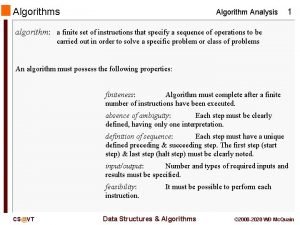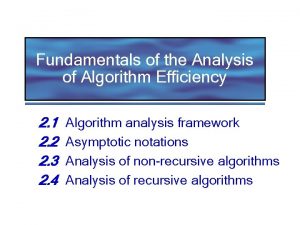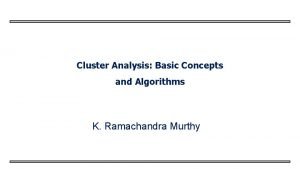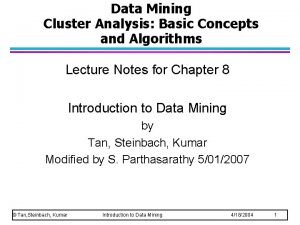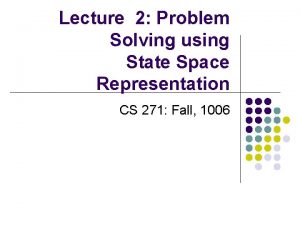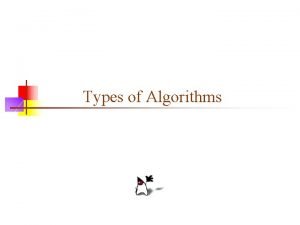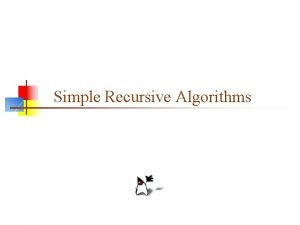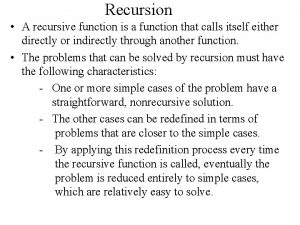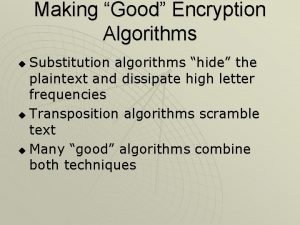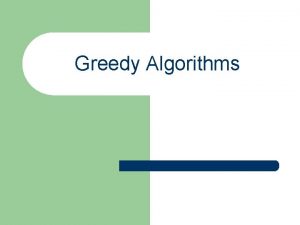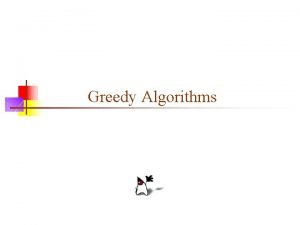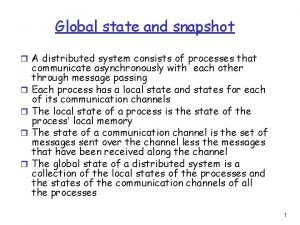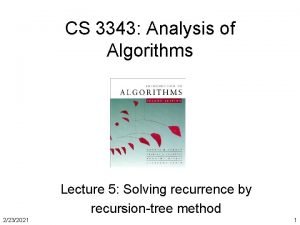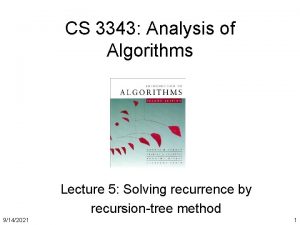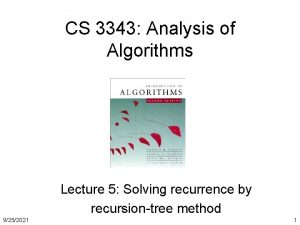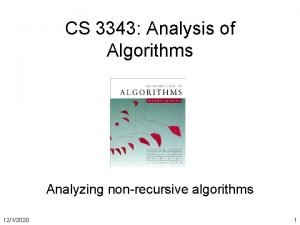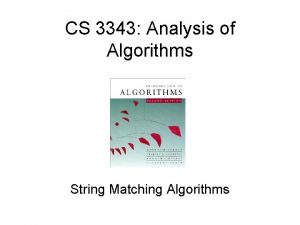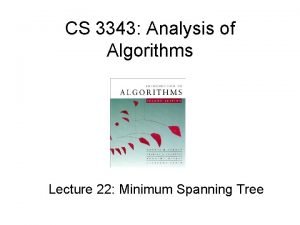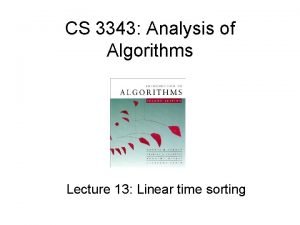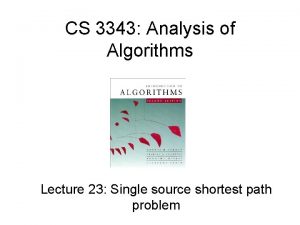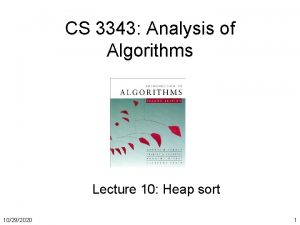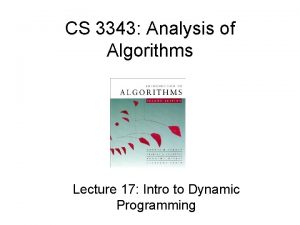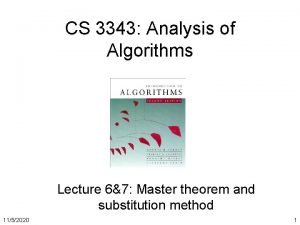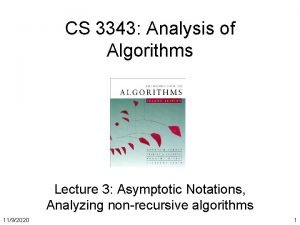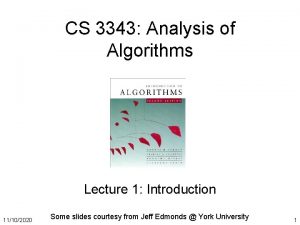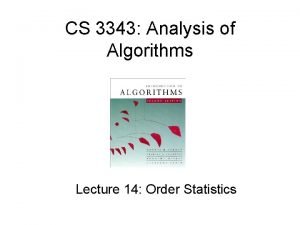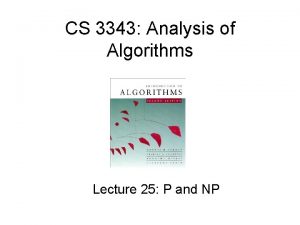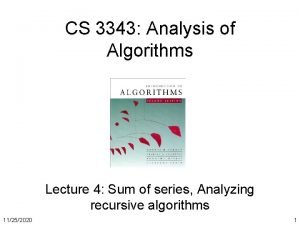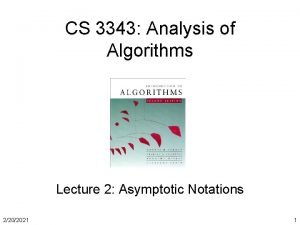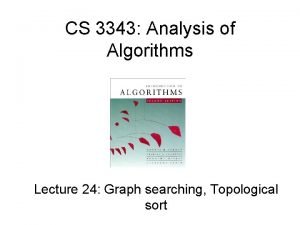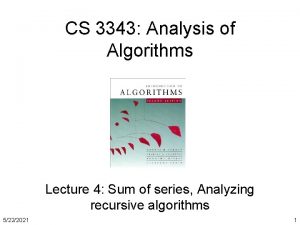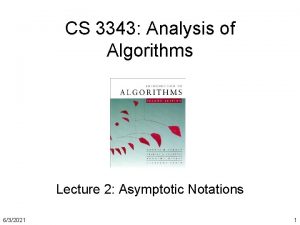CS 3343 Analysis of Algorithms Lecture 5 Solving





![Analyzing merge sort T(n) MERGE-SORT A[1. . n] Θ(1) 1. If n = 1, Analyzing merge sort T(n) MERGE-SORT A[1. . n] Θ(1) 1. If n = 1,](https://slidetodoc.com/presentation_image_h/bb685c4658f6d7623206e2a5aef52b63/image-6.jpg)

![Binary Search Binary. Search (A[1. . N], value) { if (N == 0) return Binary Search Binary. Search (A[1. . N], value) { if (N == 0) return](https://slidetodoc.com/presentation_image_h/bb685c4658f6d7623206e2a5aef52b63/image-8.jpg)
![Recursive Insertion Sort Recursive. Insertion. Sort(A[1. . n]) 1. if (n == 1) do Recursive Insertion Sort Recursive. Insertion. Sort(A[1. . n]) 1. if (n == 1) do](https://slidetodoc.com/presentation_image_h/bb685c4658f6d7623206e2a5aef52b63/image-9.jpg)

































![3 -way-merge-sort (A[1. . n]) If (n <= 1) return; 3 -way-merge-sort(A[1. . n/3]); 3 -way-merge-sort (A[1. . n]) If (n <= 1) return; 3 -way-merge-sort(A[1. . n/3]);](https://slidetodoc.com/presentation_image_h/bb685c4658f6d7623206e2a5aef52b63/image-43.jpg)
![Unbalanced-merge-sort ub-merge-sort (A[1. . n]) if (n<=1) return; ub-merge-sort(A[1. . n/3]); ub-merge-sort(A[n/3+1. . n]); Unbalanced-merge-sort ub-merge-sort (A[1. . n]) if (n<=1) return; ub-merge-sort(A[1. . n/3]); ub-merge-sort(A[n/3+1. . n]);](https://slidetodoc.com/presentation_image_h/bb685c4658f6d7623206e2a5aef52b63/image-44.jpg)


- Slides: 46

CS 3343: Analysis of Algorithms Lecture 5: Solving recurrence by recursion-tree method 11/29/2020 1

Problem of the day • How many multiplications do you need to compute 316? 316 =3 x 3 …. x 3 Answer: 15 316 =38 x 38 38 =34 x 34 34 =32 x 32 Answer: 4 32 =3 x 3 11/29/2020 2

Pseudo code int pow (b, n) // compute bn m = n >> 1; p = pow (b, m); p = p * p; if (n % 2) return p * b; else return p; 11/29/2020 3

Pseudo code int pow (b, n) m = n >> 1; p = pow (b, m); p = p * p; if (n % 2) return p * b; else return p; 11/29/2020 int pow (b, n) m = n >> 1; p = pow(b, m) * pow(b, m); if (n % 2) return p * b; else return p; 4

Outline • Review of last lecture – analyzing recursive algorithms – Defining recurrence relation • Today: analyzing recursive algorithms – Solving recurrence relation 11/29/2020 5
![Analyzing merge sort Tn MERGESORT A1 n Θ1 1 If n 1 Analyzing merge sort T(n) MERGE-SORT A[1. . n] Θ(1) 1. If n = 1,](https://slidetodoc.com/presentation_image_h/bb685c4658f6d7623206e2a5aef52b63/image-6.jpg)
Analyzing merge sort T(n) MERGE-SORT A[1. . n] Θ(1) 1. If n = 1, done. 2 T(n/2) 2. Recursively sort A[ 1. . n/2 ] and A[ n/2 +1. . n ]. f(n) 3. “Merge” the 2 sorted lists Sloppiness: Should be T( n/2 ) + T( n/2 ) , but it turns out not to matter asymptotically. 11/29/2020 6

Recurrence for merge sort 1. Divide: Trivial. 2. Conquer: Recursively sort 2 subarrays. 3. Combine: Merge two sorted subarrays T(n) = 2 T(n/2) + Θ(n) # subproblems subproblem size 11/29/2020 Dividing and Combining 7
![Binary Search Binary Search A1 N value if N 0 return Binary Search Binary. Search (A[1. . N], value) { if (N == 0) return](https://slidetodoc.com/presentation_image_h/bb685c4658f6d7623206e2a5aef52b63/image-8.jpg)
Binary Search Binary. Search (A[1. . N], value) { if (N == 0) return -1; // not found mid = (1+N)/2; if (A[mid] == value) return mid; // found else if (A[mid] > value) return Binary. Search (A[1. . mid-1], value); else return Binary. Search (A[mid+1, N], value) } 11/29/2020 8
![Recursive Insertion Sort Recursive Insertion SortA1 n 1 if n 1 do Recursive Insertion Sort Recursive. Insertion. Sort(A[1. . n]) 1. if (n == 1) do](https://slidetodoc.com/presentation_image_h/bb685c4658f6d7623206e2a5aef52b63/image-9.jpg)
Recursive Insertion Sort Recursive. Insertion. Sort(A[1. . n]) 1. if (n == 1) do nothing; 2. Recursive. Insertion. Sort(A[1. . n-1]); 3. Find index i in A such that A[i] <= A[n] < A[i+1]; 4. Insert A[n] after A[i]; 11/29/2020 9

Compute factorial Factorial (n) if (n == 1) return 1; return n * Factorial (n-1); • Note: here we use n as the size of the input. However, usually for such algorithms we would use log(n), i. e. , the bits needed to represent n, as the input size. 11/29/2020 10

Recurrence for computing power int pow (b, n) m = n >> 1; p = pow (b, m); p = p * p; if (n % 2) return p * b; else return p; T(n) = ? 11/29/2020 int pow (b, n) m = n >> 1; p=pow(b, m)*pow(b, m); if (n % 2) return p * b; else return p; T(n) = ? 11

Recurrence for computing power int pow (b, n) m = n >> 1; p = pow (b, m); p = p * p; if (n % 2) return p * b; else return p; T(n) = T(n/2)+ (1) 11/29/2020 int pow (b, n) m = n >> 1; p=pow(b, m)*pow(b, m); if (n % 2) return p * b; else return p; T(n) = 2 T(n/2)+ (1) 12

What do they mean? Challenge: how to solve the recurrence to get a closed form, e. g. T(n) = Θ (n 2) or T(n) = Θ(nlgn), or at least some bound such as T(n) = O(n 2)? 11/29/2020 13

Solving recurrence • Running time of many algorithms can be expressed in one of the following two recursive forms or Both can be very hard to solve. We focus on relatively easy ones, which you will encounter frequently in many real algorithms (and exams…) 11/29/2020 14

Solving recurrence 1. Recursion tree or iteration method - Good for guessing an answer 2. Substitution method - Generic method, rigid, but may be hard 3. Master method - Easy to learn, useful in limited cases only - Some tricks may help in other cases 11/29/2020 15

Recurrence for merge sort T(n) = (1) if n = 1; 2 T(n/2) + (n) if n > 1. We will usually ignore the base case, assuming it is always a constant (but not 0). 11/29/2020 16

Recursion tree for merge sort Solve T(n) = 2 T(n/2) + dn, where d > 0 is constant. 11/29/2020 17

Recursion tree for merge sort Solve T(n) = 2 T(n/2) + dn, where d > 0 is constant. T(n) 11/29/2020 18

Recursion tree for merge sort Solve T(n) = 2 T(n/2) + dn, where d > 0 is constant. dn T(n/2) 11/29/2020 T(n/2) 19

Recursion tree for merge sort Solve T(n) = 2 T(n/2) + dn, where d > 0 is constant. dn dn/2 T(n/4) 11/29/2020 T(n/4) dn/2 T(n/4) 20

Recursion tree for merge sort Solve T(n) = 2 T(n/2) + dn, where d > 0 is constant. dn dn/2 dn/4 … dn/4 (1) 11/29/2020 21

Recursion tree for merge sort Solve T(n) = 2 T(n/2) + dn, where d > 0 is constant. dn dn/2 dn/4 … h = log n dn/4 (1) 11/29/2020 22

Recursion tree for merge sort Solve T(n) = 2 T(n/2) + dn, where d > 0 is constant. dn dn dn/2 dn/4 … h = log n dn/4 (1) 11/29/2020 23

Recursion tree for merge sort Solve T(n) = 2 T(n/2) + dn, where d > 0 is constant. dn dn dn/2 dn/4 … h = log n dn/4 dn (1) 11/29/2020 24

Recursion tree for merge sort Solve T(n) = 2 T(n/2) + dn, where d > 0 is constant. dn dn … h = log n dn/4 dn … dn/2 (1) 11/29/2020 25

Recursion tree for merge sort Solve T(n) = 2 T(n/2) + dn, where d > 0 is constant. dn dn dn/2 dn/4 (1) 11/29/2020 dn/4 dn … … h = log n dn/4 dn #leaves = n (n) 26

Recursion tree for merge sort Solve T(n) = 2 T(n/2) + dn, where d > 0 is constant. dn dn dn/2 dn/4 (1) #leaves = n Later we will usually ignore d 11/29/2020 dn/4 dn … … h = log n dn/4 dn (n) Total (n log n) 27

Recurrence for computing power int pow (b, n) m = n >> 1; p = pow (b, m); p = p * p; if (n % 2) return p * b; else return p; T(n) = T(n/2)+ (1) 11/29/2020 int pow (b, n) m = n >> 1; p=pow(b, m)*pow(b, m); if (n % 2) return p * b; else return p; T(n) = 2 T(n/2)+ (1) Which algorithm is more efficient asymptotically? 28

Time complexity for Alg 1 Solve T(n) = T(n/2) + 1 • T(n) = T(n/2) + 1 = T(n/4) + 1 = T(n/8) + 1 + 1 = T(1) + 1 + … + 1 = Θ (log(n)) log(n) Iteration method 11/29/2020 29

Time complexity for Alg 2 Solve T(n) = 2 T(n/2) + 1. 11/29/2020 30

Time complexity for Alg 2 Solve T(n) = 2 T(n/2) + 1. T(n) 11/29/2020 31

Time complexity for Alg 2 Solve T(n) = 2 T(n/2) + 1. 1 T(n/2) 11/29/2020 T(n/2) 32

Time complexity for Alg 2 Solve T(n) = 2 T(n/2) + 1. 1 1 1 T(n/4) 11/29/2020 T(n/4) 33

Time complexity for Alg 2 Solve T(n) = 2 T(n/2) + 1. 1 1 1 … 1 (1) 11/29/2020 34

Time complexity for Alg 2 Solve T(n) = 2 T(n/2) + 1. 1 1 1 1 … h = log n (1) 11/29/2020 35

Time complexity for Alg 2 Solve T(n) = 2 T(n/2) + 1. 1 1 1 1 … h = log n (1) 11/29/2020 36

Time complexity for Alg 2 Solve T(n) = 2 T(n/2) + 1. 1 1 1 1 … h = log n 2 (1) 11/29/2020 37

Time complexity for Alg 2 Solve T(n) = 2 T(n/2) + 1. 1 1 1 … h = log n 1 1 2 1 4 … 1 1 (1) 11/29/2020 38

Time complexity for Alg 2 Solve T(n) = 2 T(n/2) + 1. 1 1 1 1 (1) 11/29/2020 1 4 … … h = log n 2 #leaves = n (n) 39

Time complexity for Alg 2 Solve T(n) = 2 T(n/2) + 1. 1 1 1 1 (1) 1 4 … … h = log n 2 #leaves = n (n) Total (n) 11/29/2020 40

More iteration method examples • T(n) = T(n-1) + 1 = T(n-2) + 1 = T(n-3) + 1 + 1 = T(1) + 1 + … + 1 = Θ (n) 11/29/2020 n-1 41

More iteration method examples • T(n) = T(n-1) + n = T(n-2) + (n-1) + n = T(n-3) + (n-2) + (n-1) + n = T(1) + 2 + 3 + … + n = Θ (n 2) 11/29/2020 42
![3 waymergesort A1 n If n 1 return 3 waymergesortA1 n3 3 -way-merge-sort (A[1. . n]) If (n <= 1) return; 3 -way-merge-sort(A[1. . n/3]);](https://slidetodoc.com/presentation_image_h/bb685c4658f6d7623206e2a5aef52b63/image-43.jpg)
3 -way-merge-sort (A[1. . n]) If (n <= 1) return; 3 -way-merge-sort(A[1. . n/3]); 3 -way-merge-sort(A[n/3+1. . 2 n/3]); 3 -way-merge-sort(A[2 n/3+1. . n]); Merge A[1. . n/3] and A[n/3+1. . 2 n/3]; Merge A[1. . 2 n/3] and A[2 n/3+1. . n]; • Is this algorithm correct? • What’s the recurrence function for the running time? • What does the recurrence function solve to? 11/29/2020 43
![Unbalancedmergesort ubmergesort A1 n if n1 return ubmergesortA1 n3 ubmergesortAn31 n Unbalanced-merge-sort ub-merge-sort (A[1. . n]) if (n<=1) return; ub-merge-sort(A[1. . n/3]); ub-merge-sort(A[n/3+1. . n]);](https://slidetodoc.com/presentation_image_h/bb685c4658f6d7623206e2a5aef52b63/image-44.jpg)
Unbalanced-merge-sort ub-merge-sort (A[1. . n]) if (n<=1) return; ub-merge-sort(A[1. . n/3]); ub-merge-sort(A[n/3+1. . n]); Merge A[1. . n/3] and A[n/3+1. . n]. • Is this algorithm correct? • What’s the recurrence function for the running time? • What does the recurrence function solve to? 11/29/2020 44

More recursion tree examples (1) • • • T(n) = 3 T(n/3) + n T(n) = T(n/3) + T(2 n/3) + n T(n) = 2 T(n/4) + n 2 T(n) = 3 T(n/2) + n 2 11/29/2020 45

More recursion tree examples (2) • • T(n) = T(n-2) + n T(n) = T(n-2) + 1 T(n) = 2 T(n-2) + n T(n) = 2 T(n-2) + 1 11/29/2020 46
 Analysis of algorithms lecture notes
Analysis of algorithms lecture notes Introduction to algorithms lecture notes
Introduction to algorithms lecture notes 01:640:244 lecture notes - lecture 15: plat, idah, farad
01:640:244 lecture notes - lecture 15: plat, idah, farad 1001 design
1001 design Algorithm analysis examples
Algorithm analysis examples Analysis of algorithms
Analysis of algorithms Association analysis: basic concepts and algorithms
Association analysis: basic concepts and algorithms What is input and output in algorithm
What is input and output in algorithm Algorithm analysis examples
Algorithm analysis examples Analysis of algorithms
Analysis of algorithms Measuring algorithm efficiency
Measuring algorithm efficiency Cluster analysis basic concepts and algorithms
Cluster analysis basic concepts and algorithms Randomized algorithms and probabilistic analysis
Randomized algorithms and probabilistic analysis Introduction of design and analysis of algorithms
Introduction of design and analysis of algorithms Cluster analysis basic concepts and algorithms
Cluster analysis basic concepts and algorithms Cluster analysis basic concepts and algorithms
Cluster analysis basic concepts and algorithms Goals of analysis of algorithms
Goals of analysis of algorithms Exercise 24
Exercise 24 Binary search in design and analysis of algorithms
Binary search in design and analysis of algorithms Introduction to the design and analysis of algorithms
Introduction to the design and analysis of algorithms Competitive analysis algorithms
Competitive analysis algorithms Design and analysis of algorithms
Design and analysis of algorithms Design and analysis of algorithms
Design and analysis of algorithms Cluster analysis basic concepts and algorithms
Cluster analysis basic concepts and algorithms Comp 482
Comp 482 Exploratory data analysis lecture notes
Exploratory data analysis lecture notes Sensitivity analysis lecture notes
Sensitivity analysis lecture notes Factor analysis lecture notes
Factor analysis lecture notes Streak plate
Streak plate Zline 667-36
Zline 667-36 State space analysis problem solving
State space analysis problem solving Computational thinking algorithms and programming
Computational thinking algorithms and programming Algorithms types
Algorithms types Common recursive algorithms
Common recursive algorithms Safe patient handling algorithms
Safe patient handling algorithms Recursion in c
Recursion in c Types of randomized algorithms
Types of randomized algorithms Process mining algorithms
Process mining algorithms Evolutionary algorithms ppt
Evolutionary algorithms ppt Nature-inspired learning algorithms
Nature-inspired learning algorithms Tabu search tsp
Tabu search tsp Making good encryption algorithms
Making good encryption algorithms Statistical algorithms
Statistical algorithms Ajit diwan
Ajit diwan Greedy algorithm
Greedy algorithm List of greedy algorithms
List of greedy algorithms What is global state in distributed system
What is global state in distributed system








